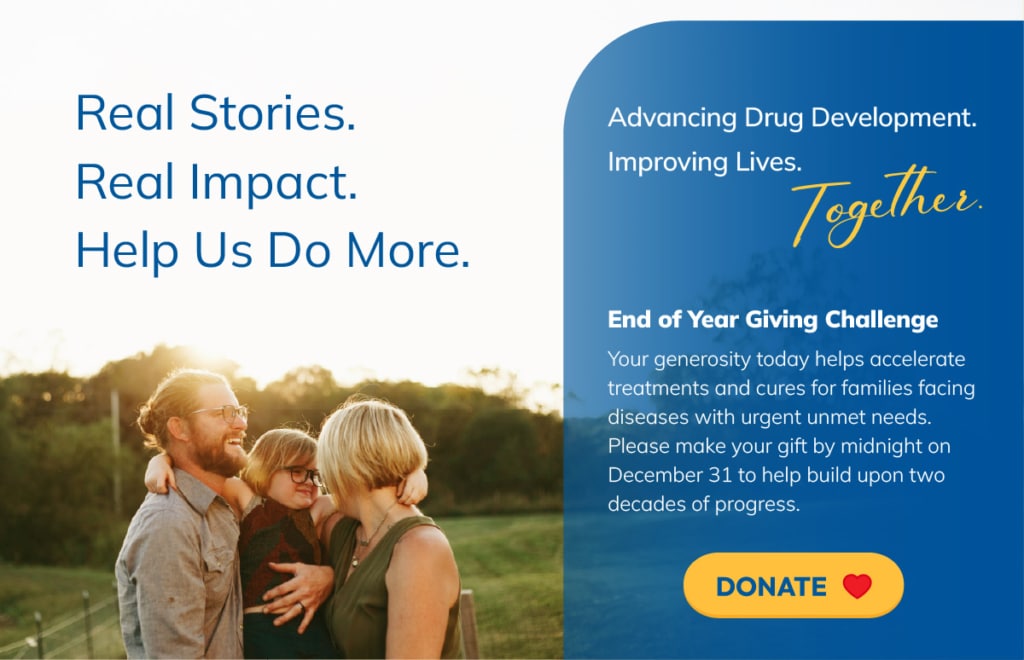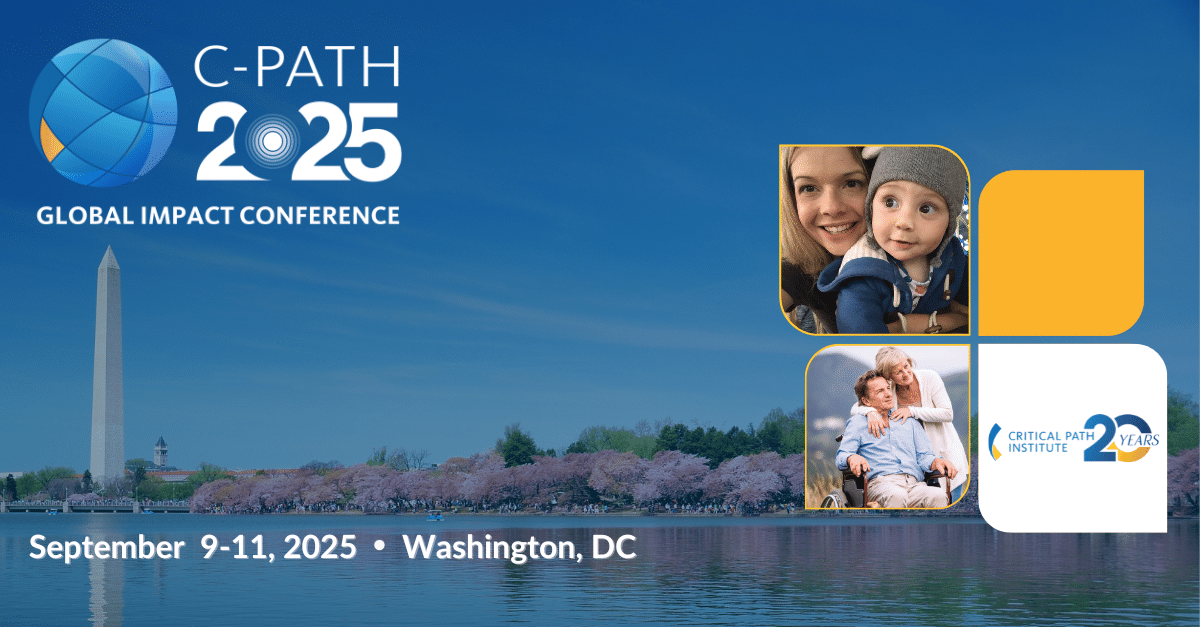
The 2025 Critical Path Institute® (C-Path) Global Impact Conference (CGIC), September 9–11, at the Washington Marriott at Metro Center in downtown Washington, D.C. was a massive success!
Building on the momentum of CGIC 2024, this year’s event brought together leaders and innovators from across the life sciences ecosystem to explore how C-Path’s collaborative programs are driving progress in neurology, rare diseases, pediatrics, and beyond. You can view all of the session recordings on C-Path’s YouTube channel by clicking the button below:
This year marked C-Path’s 20th anniversary, making CGIC 2025 a particularly meaningful occasion. It was a pleasure to connect the dots across our growing portfolio and share how C-Path can supported your goals in advancing medical innovation and improving patient outcomes worldwide.
Whether you’ve joined us from industry, regulatory agencies, academia, patient organizations, or as someone with lived experience, you’ll find valuable insights, thought-provoking discussions, and meaningful opportunities to collaborate.
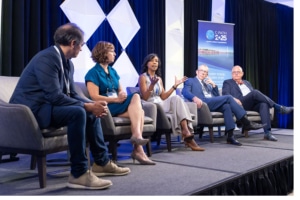
Day 1 of #CGIC2025, opened with powerful conversations on accelerating therapies, amplifying patient voices, and strengthening public-private partnerships (PPPs) to address the most pressing needs in pediatrics and rare diseases.
We began with Accelerating Therapies for Disease Modification and Interception: Removing Barriers, Realizing Impact, moderated by Klaus Romero (C-Path).
Panelists from the FDA, EMA, Sanofi, and a patient organization explored how Public-Private Partnerships can bridge discovery with clinical application across the human lifespan. The discussion underscored opportunities to align regulators, enable earlier interventions, and overcome operational and financial barriers to developing therapies for at-risk populations.
“My daughter died and I want to give as much meaning to her life as possible,” said Julia Vitarello, founder of Mila’s Miracle Foundation. “Let’s use privacy ethics to help us offer more treatments, better treatments, and not create another barrier to why millions of children can’t be treated. Every single parent I’ve talked to, hundreds around the world, would all be very happy to know that their children’s lives were meaningful in helping the next child, and that means sharing every little bit of pre-clinical data possible.”
Next, in Ensuring a Focus on Patients in Pediatrics and Rare Disease Therapy Development, patient advocates and researchers highlighted strategies for designing trials that work for children and families. From understanding socioeconomic barriers to providing better support systems, the conversation emphasized how meaningful patient engagement can drive participation and shape the future of rare disease research.
The late morning session, Development of Gene-Based Therapies in Pediatrics, addressed the promise and challenges of regenerative treatments for young individuals. Panelists explored patient, disease, and regulatory factors, while also sharing strategies to ease the burden of trial participation for families.
During the lunch break, attendees joined three interactive breakout sessions:
- Implementing New Approach Methodologies (NAMs) in Drug Development: Use Cases and What’s Still Needed, showcased the promise of human-relevant tools and the need for validation, standardization, and collaboration to advance their use in regulatory decision-making.
- RDCA-DAP Taskforces: A Novel Small-scale Public-Private Partnership Approach for Rare Disease highlighted how targeted, data-driven collaborations can accelerate regulatory-grade solutions for rare diseases.
- What Happens After Approval? Rethinking Long-Term Follow-Up in Pediatric Gene Therapy explored innovative approaches to post-approval monitoring that balance scientific rigor with the realities of pediatric care.
In the afternoon, The Missing Voices in Neonatal Drug Development: Harnessing Patient Advocacy for Impact, highlighted the lived experiences of families navigating neonatal care. Their stories, combined with perspectives from advocacy leaders and regulators, emphasized the urgency of bringing the patient voice into neonatal drug development. This was followed by Mechanism-based Drug Development for Rare and Orphan Diseases That Affect Pediatric and Adult Populations, which explored how target and disease considerations shape study design and highlighted unmet needs in developing new treatments.
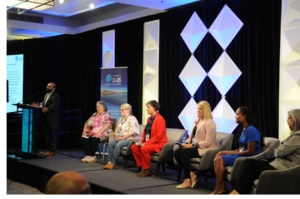
We closed with a Call to Action: Looking to the Future of Public-Private Partnerships for Pediatrics and Rare Diseases, where panelists reflected on Day 1 themes and discussed how to optimize global collaborations across disciplines. The conversation reinforced a central idea: PPPs remain vital to translating science into solutions for patients.
Day 1 reminded us that progress depends on the convergence of science, regulation, and patient experience — and together, we are building the foundation for a healthier future.
C-Path’s Global Impact Conference | Every Stage, Every Step: Transforming Lives Through Optimized Drug Development | Day 2 Recap
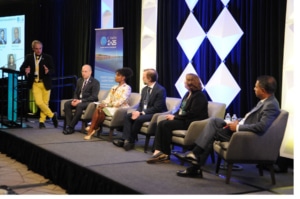
Day 2 of the C-Path Global Impact Conference carried the baton from opening day, bringing together leaders, advocates, and researchers to explore how patient voices and innovative partnerships are transforming drug development.
We began with a deep dive into modernizing the entire evidence generation enterprise, where speakers underscored how adaptive trial designs, real-world data, and human-centric translation are reshaping the future of actionable evidence generation.
“Before we’re executing trials and finalizing protocols, we’re taking steps to really look at who the patient is to make sure they are reflected in the trials,” said LaShell Robinson (Takeda). “I know that at times people think this is slowing down the trial, but if you think about it logically starting where the patient is and trying to make those connections, engaging with patient advocacy to understand the different patient journeys, actually speeds up the trial.”
“When I paint with a broad brush on what’s working in industry and what’s not working in industry, what’s working is C-Path, and C-Path is not congratulated enough on this intersection — the quality of the regulatory science that has happened very quietly is extraordinary,” said Amitabh Chandra (Harvard Business School).
The conversation continued with a powerful patient-focused drug development panel, centered on the lived experiences of patients, caregivers, and advocates in shaping more compassionate, effective treatments.
The late morning session, Connecting the Dots: Disease Interception in Parkinson’s and Type 1 Diabetes, highlighted surprising parallels between the two diseases and the opportunities for cross-disease learning to advance early intervention.
At midday, attendees explored three breakout sessions running in parallel:
- Applying FDA’s PFDD Roadmap to Digital Measures in Rare Neurodegenerative Diseases – showcasing how patient input and regulatory alignment guide innovative outcome assessments.
- C-Path’s Disease Model Coalition – rethinking traditional approaches to accelerate therapy development across therapeutic areas.
- Critical Path Data and Analytics Platform (CP-DAP) Demo – a hands-on look at C-Path’s secure, collaborative platform advancing regulatory-grade research.
The afternoon continued with sessions on greater equity in Parkinson’s research through the Global Evidence in Medicine-Parkinson’s Disease initiative, where patient advocates and scientists emphasized the urgent need to amplify women’s voices in clinical trials, and a compelling discussion on surrogate endpoints in PKD and Alzheimer’s.
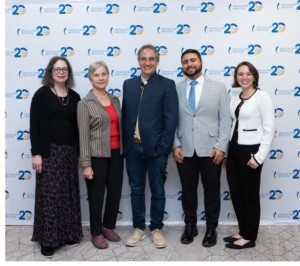
We closed the day with a forward-looking panel on public-private partnerships and early disease interception, underscoring the transformative potential of collaboration across sectors.
Day 2 left us inspired by the ways those with lived experience, regulators, researchers and industry are coming together to reimagine what’s possible.
Critical Path Institute® (C-Path) featured the outcomes of CGIC. Over three days of working sessions, regulators, industry leaders, researchers, clinicians, and patient advocates outlined priority actions and next steps to further strengthen collaborations that accelerate drug development across rare diseases, neurology, type-1 diabetes, and pediatrics — with the voices of those with lived experience playing a critical role in shaping the discussions.
Each day opened with a powerful keynote dialogue that set the tone and priorities and closed with tangible commitments—turning discussion into action and ensuring momentum carried forward.
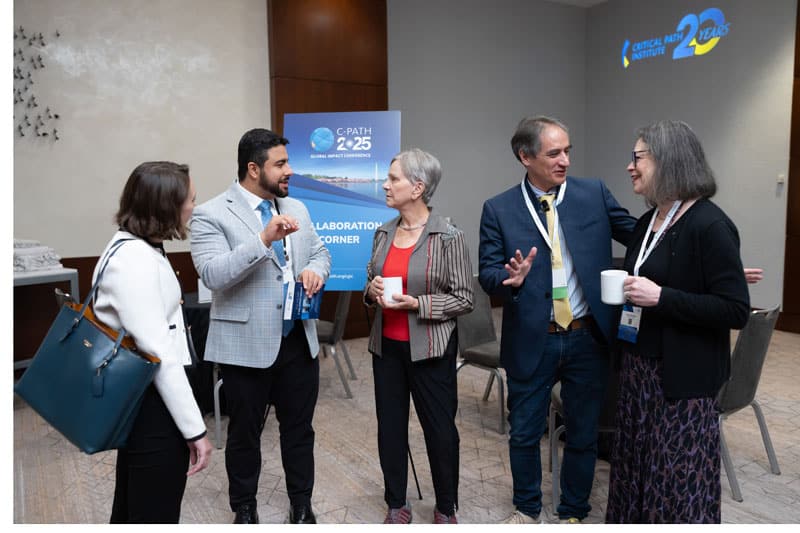
Day 1, the opening plenary, Accelerating Therapies for Disease Modification and Interception: Removing Barriers, Realizing Impact, focused on strategies to accelerate the development of therapies for earlier stages of disease, and ways to reduce delays in development. The session on Development of Gene-Based Therapies in Pediatrics addressed critical considerations around trial design, safety, and equitable access for children and families. Breakout discussions on Implementing New Approach Methodologies in Drug Development: Use Cases and What’s Still Needed highlighted practical applications and identified the tools, data, and standards required to support future regulatory decisions.
Day 2 focused on modernizing generating evidence that is both patient-centered and actionable. The opening session, Modernizing Clinical Trials: Practical Innovations to Optimize Evidence Generation, explored approaches to transform the entire evidence generation enterprise, to optimize human-centric translation, make trials more efficient and relevant, including selecting endpoints that matter to patients, integrating digital measures that function seamlessly at clinical sites, and improving data quality while reducing burden. Putting People First: Patient-Focused Drug Development brought the lived experience into the conversation, emphasizing its role in shaping study design, consent processes, and long-term follow-up. A global spotlight session, Global Evidence in Medicine–Parkinson’s Disease: Women as the Missing Voice in Parkinson’s, outlined specific steps to close long-standing data gaps and strengthen representation in research protocols and analyses.
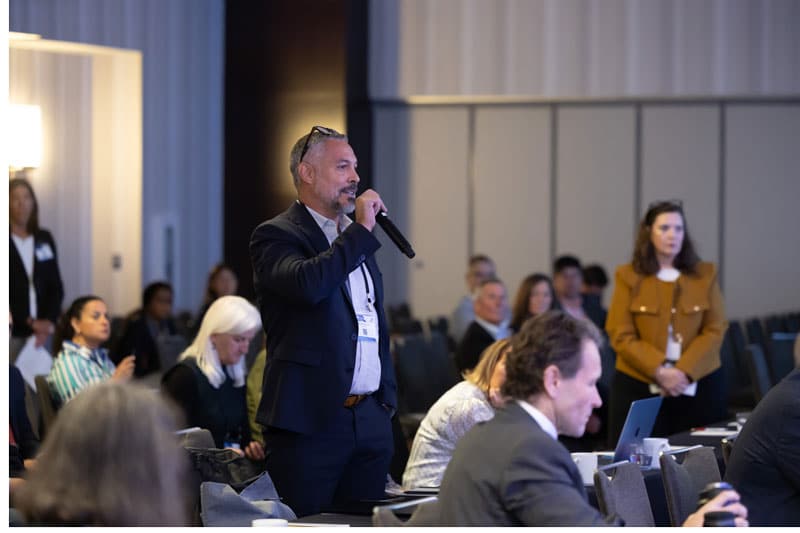
Soania Mathur, M.D., shared a moving poem about her experience as a woman living with Parkinson’s, emphasizing the need to spark a movement toward research that investigates sex-based differences underlying the disease. She underscored the critical importance of generating high-quality evidence to identify reliable, sex-specific biomarkers and social determinants of health, as well as to inform the development of tailored treatments and clinical guidelines.
C-Path is uniquely positioned to help drive this shift, having curated more than 15,000 patient data records for women with Parkinson’s disease. This growing evidence base serves as a powerful resource to advance individualized and precision medicine approaches—ensuring that research reflects real patient experiences and translates into care strategies that improve quality of life for women and, ultimately, the entire Parkinson’s community.
C-Path Concludes 2025 Global Impact Conference with Progress Across Rare Diseases, Neurology and Pediatrics
Day 3 placed advocacy and real-world evidence at the center of the conversation. Today’s Voices, Tomorrow’s Treatments: The Growing Role of Patient Advocacy in Innovation highlighted how coalitions succeed when priorities are aligned, decisions are transparent, and credit is shared across partners. Real-World Data for Drug Development examined strategies to generate decision-ready evidence from real settings while minimizing unnecessary complexity for participants and clinical sites.
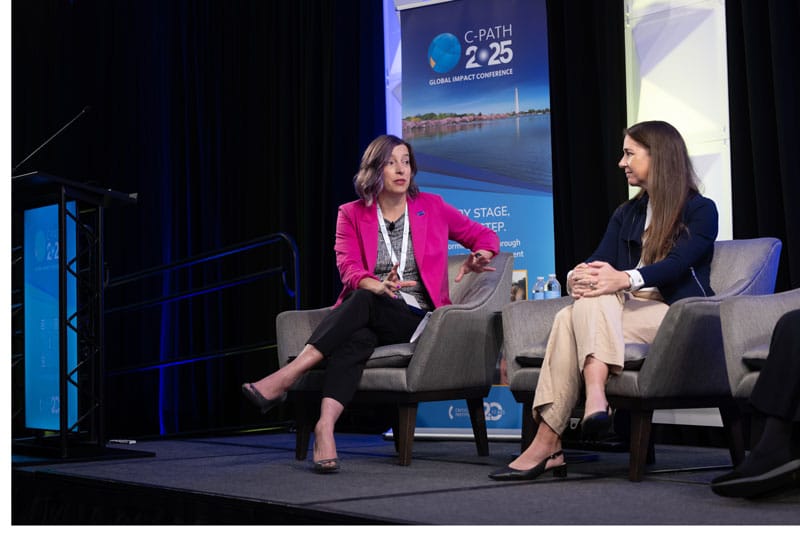
“CGIC is about turning dialogue into action and outcomes,” said Klaus Romero, M.D., M.S., FCP, Chief Executive Officer of C-Path. “We come away from CGIC with clear priorities, defined actions, and the collaborations needed to carry them forward. For the individuals and families we serve, every day matters. Our job is to make those days count.”
Regulators were integral to the discussions throughout the Global Impact Conference, reinforcing the importance of generating evidence that drives meaningful decisions. They emphasized that patients cannot afford wasted time, underscoring the need for measures that truly matter to patients, study designs that work in real-world clinical settings, and proposals that are clear in purpose, proportionate in risk, and built to deliver learning quickly. By focusing on the right questions, regulators stressed, the field can move treatments to the people who need them faster.
Individuals with living experiences brought a critical perspective to the week’s sessions.
“What we are starting to realize is that discovery-science really needs the patient experience. We don’t have a lot of people that look like me as patient advocates or in clinical trials,” said Glenda V. Roberts, Mount Sinai Health System. “We need to make a stronger effort to make sure that there are more diverse people represented. I’m talking about the lived experiences, different age groups, different experiences for rich genetic biological information that we need to understand.”
Industry and academic partners stressed the importance of alignment. “Before we’re executing trials and finalizing protocols, we’re taking steps to really look at who the patient is to make sure they are reflected in the trials,” said LaShell Robinson, Takeda. “I know that at times people think this is slowing down the trial, but if you think about it logically starting where the patient is and trying to make those connections, engaging with patient advocacy to understand the different patient journeys, actually speeds up trials.”
Full session recordings will be published on C-Path’s YouTube channel. To be notified when videos are available, subscribe to C-Path news and select CGIC updates at c-path.org/subscribe.


